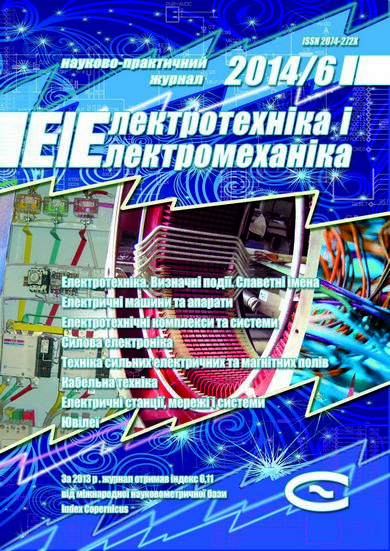MAGNETIC FIELD IN A GAP OF ELECTROMECHANICAL DISINTEGRATORS
DOI:
https://doi.org/10.20998/2074-272X.2014.6.08Keywords:
air gap, magnetic field, winding, electromechanical disintegratorAbstract
The magnetic field created in an air gap of electromechanical disintegrators as a result of actions of two opposite running magnetic fields is considered. It is shown that motionless pulsing fields are as a result formed, which can be formed in much simpler and more effective way.
References
Shinkarenko V.F., Kotliarova V.V. Evolutionary experiments in structural electromechanics. Materialy mezhd. nauchn.-tekhn. konf. "Problemy povysheniia elektromekhanicheskikh preobrazovatelei v elektromekhanicheskikh sistemakh" [Materials Int. sci.-techn. conf. "Problems of increase of electromechanical transducers in electromechanical systems"]. Sevastopol, SevNTU, 2012, pp. 7-12.
Lushchik V.D. A chromosomal-genetic theory of electromechanical systems by the example of electromechanical disintegrators. Elektrotekhnіka і elektromekhanіka – Electrical engineering & electromechanics, 2012, no.6, pp. 28-30.
Shinkarenko V.F., Kotliarova V.V. Chumak V.V. Research of efficiency of using electromechanical disintegrators multifactorial actions activation technologies portland cement. Materialy mezhd. nauchn.-tekhn. konf. "Problemy povysheniia elektromekhanicheskikh preobrazovatelei v elektromekhanicheskikh sistemakh" [Materials Int. sci.-techn. conf. "Problems of increase of electromechanical transducers in electromechanical systems"]. Sevastopol, SevNTU, 2013, pp. 171-174.
Zablodskiy N.N., Filatov M.A., Gritsyuk V.Yu. Modeling of electromagnetic field electromechanical disintegrator. Sbornik nauchnykh trudov Donbasskogo gosudarstvennogo tekhnicheskogo universiteta – The Collection of proceedings of Donbass State Technical University, 2013, no.39, pp. 221-226.
Shinkarenko V.F. Osnovy teorii evoliutsii elektromekhanichnykh system [The basics of evolution theory of electromechanical systems]. Kyiv, Naukova dumka Publ., 2002. 288 p.
Downloads
Published
How to Cite
Issue
Section
License
Copyright (c) 2015 V. D. Lushchik

This work is licensed under a Creative Commons Attribution-NonCommercial 4.0 International License.
Authors who publish with this journal agree to the following terms:
1. Authors retain copyright and grant the journal right of first publication with the work simultaneously licensed under a Creative Commons Attribution License that allows others to share the work with an acknowledgement of the work's authorship and initial publication in this journal.
2. Authors are able to enter into separate, additional contractual arrangements for the non-exclusive distribution of the journal's published version of the work (e.g., post it to an institutional repository or publish it in a book), with an acknowledgement of its initial publication in this journal.
3. Authors are permitted and encouraged to post their work online (e.g., in institutional repositories or on their website) prior to and during the submission process, as it can lead to productive exchanges, as well as earlier and greater citation of published work.





